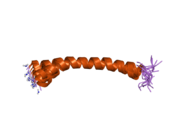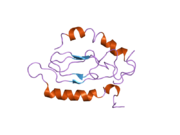Hipofizni adenilat ciklazno aktivirajući peptid
| Hipofizni adenilat ciklazno aktivirajući peptid | |||||||||||
|---|---|---|---|---|---|---|---|---|---|---|---|
 | |||||||||||
| Dostupne strukture | |||||||||||
| 1GEA, 2D2P, 2JOD | |||||||||||
| Identifikatori | |||||||||||
| Simboli | ADCYAP1; PACAP | ||||||||||
| Vanjski ID | OMIM: 102980 MGI: 105094 HomoloGene: 869 GeneCards: ADCYAP1 Gene | ||||||||||
| |||||||||||
| Pregled RNK izražavanja | |||||||||||
 | |||||||||||
| podaci | |||||||||||
| Ortolozi | |||||||||||
| Vrsta | Čovek | Miš | |||||||||
| Entrez | 116 | 11516 | |||||||||
| Ensembl | ENSG00000141433 | ENSMUSG00000024256 | |||||||||
| UniProt | P18509 | O70176 | |||||||||
| RefSeq (mRNA) | NM_001099733.1 | NM_009625.2 | |||||||||
| RefSeq (protein) | NP_001093203.1 | NP_033755.1 | |||||||||
| Lokacija (UCSC) |
Chr 18: 0.9 - 0.91 Mb |
Chr 17: 93.6 - 93.6 Mb | |||||||||
| PubMed pretraga | [1] | [2] | |||||||||
Hipofizni adenilat ciklazno aktivirajući peptid (PACAP) je protein koji je kod ljudi kodiran ADCYAP1 genom.[1][2] PACAP je sličan sa vazoaktivnim intestinalnim peptidom. Jedan od njegovih efekata je stimulacija enterohromafinu sličnih ćelija. On se vezuje za receptor vazoaktivnog intestinalnog peptida.
Funkcija
[уреди | уреди извор]Posredstvom hipofiznog adenilat ciklazno aktivirajućeg polipeptidnog receptor tipa I, ovaj polipeptid stimuliše adenilat ciklazu i naknadno povišava nivoe cAMP u ciljnim ćelijama. Adenilat ciklazno aktivirajući peptid 1 nije samo hipofiziotropni hormon, nego takođe funkcioniše kao neurotransmiter i neuromodulator. Osim toga on učestvuje u parakrinoj i autokrinoj regulacije pojedinih tipova ćelija. Ovaj gen se sastoji of pet eksona. Eksoni 1 i 2 kodiraju 5' UTR i signalni peptid, respektivno; ekson 4 kodira peptid srodan adenilat ciklazno aktivirajućem polipeptidu; i ekson 5 kodira maturisani peptid i 3' UTR. Ovaj gen kodira tri različita peptida, uključujući dva izotipa: kratku i dugačku formu.[2]
Interakcije
[уреди | уреди извор]Hipofizni adenilat ciklazno aktivirajući peptid formira interakcije sa sektretinskim receptorom.[3]
Reference
[уреди | уреди извор]- ^ Hosoya M; Kimura C; Ogi K; Ohkubo S; Miyamoto Y; Kugoh H; Shimizu M; Onda H; Oshimura M; Arimura A; et al. (1992). „Structure of the human pituitary adenylate cyclase activating polypeptide (PACAP) gene”. Biochim Biophys Acta. 1129 (2): 199—206. PMID 1730060.
- ^ а б „Entrez Gene: ADCYAP1 adenylate cyclase activating polypeptide 1 (pituitary)”.
- ^ Felley, C P; Qian J M; et al. (1992). „Chief cells possess a receptor with high affinity for PACAP and VIP that stimulates pepsinogen release”. Am. J. Physiol. UNITED STATES. 263 (6 Pt 1): G901—7. ISSN 0002-9513. PMID 1335692.
Literatura
[уреди | уреди извор]- Conconi MT, Spinazzi R, Nussdorfer GG (2006). „Endogenous ligands of PACAP/VIP receptors in the autocrine-paracrine regulation of the adrenal gland.”. Int. Rev. Cytol. 249: 1—51. PMID 16697281. doi:10.1016/S0074-7696(06)49001-X.
- Cross SH, Charlton JA, Nan X, Bird AP (1994). „Purification of CpG islands using a methylated DNA binding column.”. Nat. Genet. 6 (3): 236—44. PMID 8012384. doi:10.1038/ng0394-236.
- Dautzenberg FM, Mevenkamp G, Wille S, Hauger RL (2000). „N-terminal splice variants of the type I PACAP receptor: isolation, characterization and ligand binding/selectivity determinants.”. J. Neuroendocrinol. 11 (12): 941—9. PMID 10583729. doi:10.1046/j.1365-2826.1999.00411.x.
- Fahrenkrug J (2002). „Gut/brain peptides in the genital tract: VIP and PACAP.”. Scand. J. Clin. Lab. Invest. Suppl. 234: 35—9. PMID 11713978.
- Fahrenkrug J (2006). „PACAP--a multifacetted neuropeptide.”. Chronobiol. Int. 23 (1-2): 53—61. PMID 16687279. doi:10.1080/07420520500464569.
- Felley CP; Qian JM; Mantey S; et al. (1993). „Chief cells possess a receptor with high affinity for PACAP and VIP that stimulates pepsinogen release.”. Am. J. Physiol. 263 (6 Pt 1): G901—7. PMID 1335692.
- Geng L, Ju G (2000). „[The discovery of pituitary adenylate cyclase activating polypeptide (PACAP) and its research progress]”. Sheng li ke xue jin zhan [Progress in physiology]. 28 (1): 29—34. PMID 10921074.
- Gourlet P, Vandermeers A, Robberecht P, Deschodt-Lanckman M (1997). „Vasoactive intestinal peptide (VIP) and pituitary adenylate cyclase-activating peptide (PACAP-27, but not PACAP-38) degradation by the neutral endopeptidase EC 3.4.24.11.”. Biochem. Pharmacol. 54 (4): 509—15. PMID 9313778. doi:10.1016/S0006-2952(97)00207-4.
- Inagaki N; Yoshida H; Mizuta M; et al. (1994). „Cloning and functional characterization of a third pituitary adenylate cyclase-activating polypeptide receptor subtype expressed in insulin-secreting cells.”. Proc. Natl. Acad. Sci. U.S.A. 91 (7): 2679—83. PMC 43433
 . PMID 8146174. doi:10.1073/pnas.91.7.2679.
. PMID 8146174. doi:10.1073/pnas.91.7.2679. - Inooka H; Endo S; Kitada C; et al. (1993). „Pituitary adenylate cyclase activating polypeptide (PACAP) with 27 residues. Conformation determined by 1H NMR and CD spectroscopies and distance geometry in 25% methanol solution.”. Int. J. Pept. Protein Res. 40 (5): 456—64. PMID 1483839. doi:10.1111/j.1399-3011.1992.tb00324.x.
- Kimura C; Ohkubo S; Ogi K; et al. (1990). „A novel peptide which stimulates adenylate cyclase: molecular cloning and characterization of the ovine and human cDNAs.”. Biochem. Biophys. Res. Commun. 166 (1): 81—9. PMID 2302217. doi:10.1016/0006-291X(90)91914-E.
- Nakata M, Yada T (2007). „PACAP in the glucose and energy homeostasis: physiological role and therapeutic potential.”. Curr. Pharm. Des. 13 (11): 1105—12. PMID 17430174. doi:10.2174/138161207780618948.
- Ohkubo S; Kimura C; Ogi K; et al. (1992). „Primary structure and characterization of the precursor to human pituitary adenylate cyclase activating polypeptide.”. DNA Cell Biol. 11 (1): 21—30. PMID 1739432. doi:10.1089/dna.1992.11.21.
- Ohtaki T; Masuda Y; Ishibashi Y; et al. (1994). „Purification and characterization of the receptor for pituitary adenylate cyclase-activating polypeptide.”. J. Biol. Chem. 268 (35): 26650—7. PMID 8253796.
- Pérez-Jurado LA, Francke U (1993). „Dinucleotide repeat polymorphism at the human pituitary adenylate cyclase activating polypeptide (PACAP) gene.”. Hum. Mol. Genet. 2 (6): 827. PMID 8353512. doi:10.1093/hmg/2.6.827-a.
- Waschek JA (2002). „Multiple actions of pituitary adenylyl cyclase activating peptide in nervous system development and regeneration.”. Dev. Neurosci. 24 (1): 14—23. PMID 12145407. doi:10.1159/000064942.
- Weber B; Riess O; Daneshvar H; et al. (1993). „(CA)n-dinucleotide repeat at the PDEB locus in 4p16.3.”. Hum. Mol. Genet. 2 (6): 827. PMID 8394765. doi:10.1093/hmg/2.6.827.
- Wray V, Kakoschke C, Nokihara K, Naruse S (1993). „Solution structure of pituitary adenylate cyclase activating polypeptide by nuclear magnetic resonance spectroscopy.”. Biochemistry. 32 (22): 5832—41. PMID 8504103. doi:10.1021/bi00073a016.
- Zeng N; Athmann C; Kang T; et al. (1999). „PACAP type I receptor activation regulates ECL cells and gastric acid secretion.”. J. Clin. Invest. 104 (10): 1383—91. PMC 409843
 . PMID 10562300. doi:10.1172/JCI7537.
. PMID 10562300. doi:10.1172/JCI7537.
Vidi još
[уреди | уреди извор]Spoljašnje veze
[уреди | уреди извор]- Pituitary+adenylate+cyclase-activating+polypeptide на US National Library of Medicine Medical Subject Headings (MeSH)


